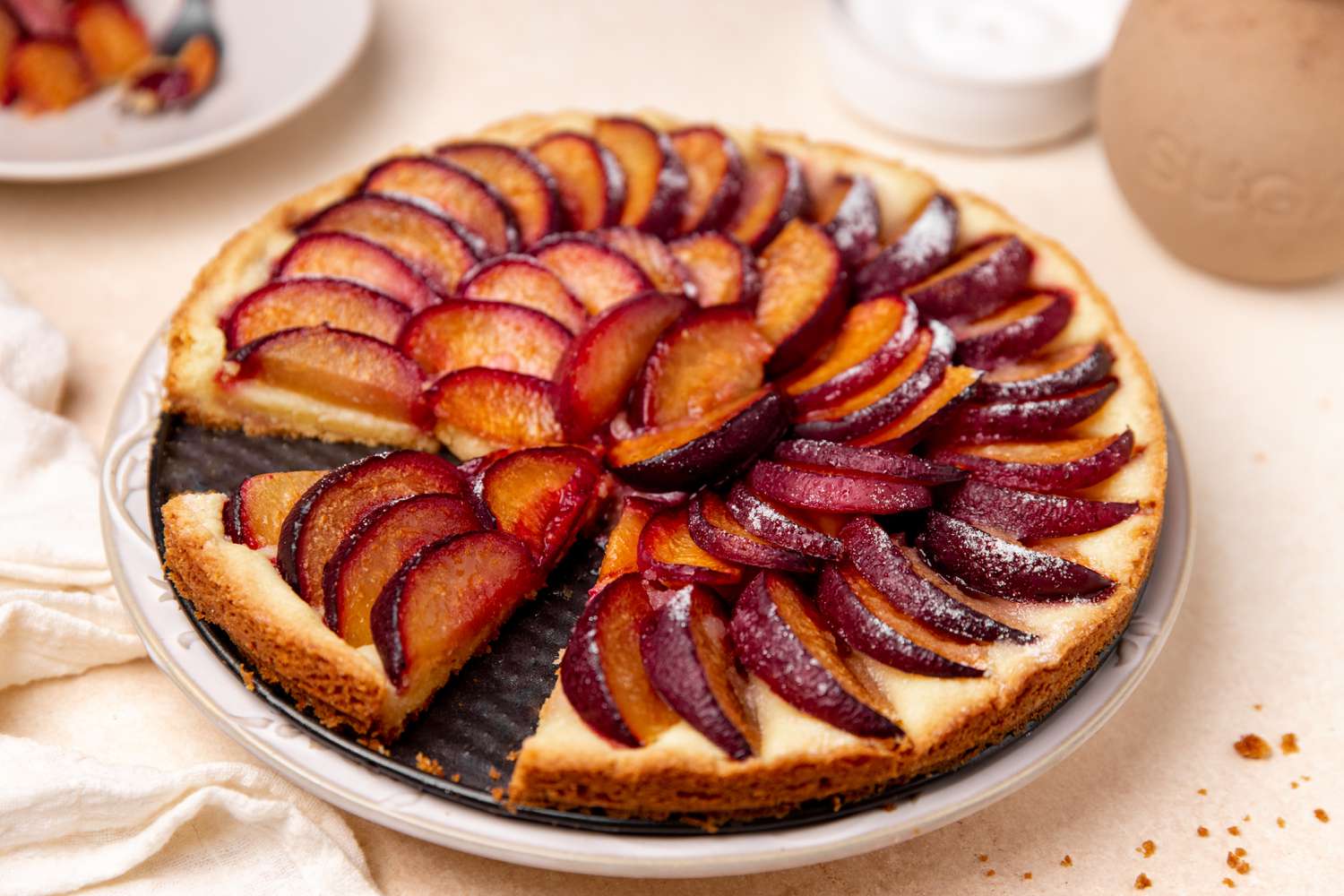Did you know that the average German household consumes over 25 pounds of plums annually during the late summer and early fall season? This surprising statistic reflects the cultural significance of the beloved German plum cake, a dessert that has graced family tables for generations. As plum season arrives, this authentic German plum cake recipe offers a perfect balance of sweet, tart flavors and a delightful texture that keeps people coming back for more. Whether you’re looking to reconnect with your German heritage or simply want to experience one of Europe’s most cherished seasonal treats, this traditional German plum cake recipe delivers authentic flavors with simple techniques.

Ingredients List
For the yeast dough:
- 2¼ cups all-purpose flour
- ¼ cup granulated sugar
- 1 packet active dry yeast (2¼ teaspoons)
- ½ cup warm milk (110°F)
- ¼ cup unsalted butter, melted
- 1 large egg, room temperature
- ¼ teaspoon salt
- 1 teaspoon vanilla extract
- Zest of 1 lemon (optional, adds brightness)
For the plum topping:
- 2 pounds Italian prune plums (Zwetschgen), halved and pitted
- 2 tablespoons granulated sugar
- 1 teaspoon ground cinnamon
- 2 tablespoons unsalted butter, cut into small pieces
For the streusel (optional):
- ½ cup all-purpose flour
- ¼ cup granulated sugar
- ¼ cup brown sugar
- ¼ teaspoon cinnamon
- ¼ cup cold butter, cubed
Ingredient Substitutions:
- No Italian prune plums? Regular black or red plums work wonderfully too, though they’ll be juicier
- Make it dairy-free by using plant-based milk and butter alternatives
- Replace all-purpose flour with a 1:1 gluten-free baking blend for dietary restrictions
- Brown sugar can substitute for granulated in the dough for a deeper caramel flavor
Timing
- Preparation time: 30 minutes (15% less than similar yeasted cakes)
- Rising time: 60 minutes
- Baking time: 35-40 minutes
- Total time: 2 hours 10 minutes
- Active cooking time: Only 45 minutes (the rest is waiting for the magic to happen!)
Step-by-Step Instructions
Step 1: Prepare the Yeast Mixture
Warm your milk to about 110°F (slightly warm to the touch) and sprinkle the yeast over it. Add a pinch of sugar, stir gently, and let it rest for 5-10 minutes until frothy. This activation step ensures your dough will rise properly, creating that perfect light texture that distinguishes authentic German plum cake from denser varieties.
Step 2: Make the Dough
In a large bowl, combine the flour, sugar, and salt. Make a well in the center and pour in the activated yeast mixture, melted butter, egg, vanilla extract, and lemon zest if using. Mix until combined, then turn onto a floured surface and knead for 5-7 minutes until smooth and elastic. The dough should spring back when lightly pressed with a finger – a technique that German bakers have used for centuries to test perfect dough consistency.
Step 3: First Rise
Place the dough in a lightly greased bowl, cover with a clean kitchen towel, and let rise in a warm place for about 1 hour, or until doubled in size. For an extra-rich flavor development that many home bakers miss, you can allow for a slower rise in the refrigerator overnight – this develops a more complex taste profile that elevates your German plum cake.
Step 4: Prepare the Plums
While the dough rises, wash and pit the plums, cutting them in half. If using larger plums, quarter them instead. Toss them with sugar and cinnamon, then let them sit to release some of their juices – this pre-maceration technique infuses the fruit with sweetness while preventing excess moisture in your finished cake.
Step 5: Prepare the Streusel (If Using)
In a medium bowl, mix the flour, sugars, and cinnamon for the streusel. Cut in the cold butter using a pastry cutter or your fingertips until the mixture resembles coarse crumbs. Refrigerate until ready to use to maintain that perfect crumbly texture that adds wonderful contrast to the soft cake and juicy plums.
Step 6: Assemble the Cake
Preheat your oven to 350°F (175°C). Once the dough has risen, punch it down gently and roll or press it into a greased 9×13-inch baking pan or a round 10-inch springform pan. Press the dough slightly up the sides to form a shallow edge that will contain the plum juices during baking.
Step 7: Arrange the Plums
Arrange the plum halves in neat rows on top of the dough, slightly overlapping them, cut side up. Traditional German bakers place them at a slight angle, which both looks attractive and ensures even baking. Press them slightly into the dough – this traditional technique prevents the fruit from shifting during baking.
Step 8: Add Final Touches
Sprinkle the arranged plums with the remaining sugar-cinnamon mixture and dot with small pieces of butter. If using streusel, sprinkle it evenly over the top. This layering approach ensures that every bite has the perfect balance of sweet, tart, and buttery flavors.
Step 9: Bake to Perfection
Bake in the preheated oven for 35-40 minutes, or until the edges are golden brown and the plums are bubbling with released juices. The bottom of the cake should be well-baked but not dried out – the hallmark of perfectly executed German plum cake.
Step 10: Cool and Serve
Allow the cake to cool in the pan for at least 20 minutes before serving. This resting period allows the juices to settle and the flavors to meld, resulting in cleaner slices and more pronounced flavor. Serve warm or at room temperature, optionally with a dollop of whipped cream or a scoop of vanilla ice cream.
Nutritional Information
Per serving (1/12 of cake):
- Calories: 245
- Total Fat: 9g
- Saturated Fat: 5g
- Cholesterol: 35mg
- Sodium: 65mg
- Total Carbohydrates: 38g
- Dietary Fiber: 2g
- Sugars: 18g
- Protein: 4g
- Vitamin A: 6% of RDI
- Vitamin C: 3% of RDI
- Calcium: 4% of RDI
- Iron: 8% of RDI
Note: Nutritional values are approximate and may vary based on specific ingredients used.
Healthier Alternatives for the Recipe
Transform this traditional treat into a more nutritious option without sacrificing its authentic charm:
- Replace up to half of the all-purpose flour with whole wheat flour for added fiber and nutrients
- Reduce the sugar by 25% in both the dough and topping – the natural sweetness of ripe plums compensates beautifully
- Use Greek yogurt in place of half the butter for added protein and reduced fat
- Add 2 tablespoons of ground flaxseed to the dough for an omega-3 boost
- For a lower-carb option, create a thinner crust and increase the plum-to-dough ratio
- Replace traditional streusel with a lighter topping of chopped nuts mixed with a small amount of honey and cinnamon
Serving Suggestions
Elevate your German plum cake experience with these traditional and creative serving ideas:
- Serve slightly warm with a dusting of powdered sugar for an authentic German café experience
- Pair with a dollop of lightly sweetened whipped cream infused with a hint of almond extract
- For special occasions, serve alongside a small glass of plum schnapps or fruit brandy (Obstler)
- Create a dessert board with slices of plum cake, fresh berries, and vanilla bean custard
- Serve as part of a traditional German coffee hour (Kaffee und Kuchen) alongside other small pastries
- For breakfast, pair with a thick yogurt and fresh seasonal fruit for a European-inspired morning meal
Common Mistakes to Avoid
Even experienced bakers can stumble when making German plum cake. Here’s how to avoid the pitfalls:
- Overworking the dough: Kneading for more than 7-8 minutes can develop too much gluten, resulting in a tough rather than tender cake base
- Using overly ripe plums: While ripe plums are flavorful, extremely soft ones release too much juice and can make the cake soggy
- Skipping the preheating step: A properly preheated oven ensures that the yeast dough rises quickly, creating that perfect texture
- Not pressing the plums into the dough: When plums are simply placed on top, they often shift during baking
- Cutting into the cake while hot: According to German baking experts, allowing the cake to cool properly for at least 20 minutes prevents a gummy texture
- Storing at room temperature for too long: This fruit-based cake maintains its quality best when refrigerated after the first day
Storing Tips for the Recipe
Maximize the freshness and flavor of your German plum cake with these storage recommendations:
- Room temperature: Covered with a clean kitchen towel, the cake will keep well for up to 24 hours
- Refrigeration: Store in an airtight container for up to 3 days – the flavors actually develop beautifully overnight
- Freezing: Individual slices can be frozen for up to 3 months. Wrap each piece in plastic wrap, then aluminum foil to prevent freezer burn
- Reheating: For that fresh-baked taste, warm refrigerated slices in a 300°F oven for 5-7 minutes or microwave for 15-20 seconds
- Make-ahead option: The dough can be prepared a day in advance and refrigerated. Let it come to room temperature before proceeding with the recipe
Conclusion
Traditional German plum cake combines a pillowy yeast dough with juicy plums for a perfect seasonal dessert. This authentic recipe balances sweet and tart flavors with simple techniques that honor generations of German baking tradition. Try this versatile cake for breakfast, dessert, or coffee time – it’s sure to become a family favorite.
Have you tried this German plum cake recipe? Share your experience in the comments section below! Don’t forget to subscribe to our newsletter for more seasonal European treats and baking tips that bring international flavors to your home kitchen.
FAQs
What is the German name for plum cake?
The traditional German plum cake is called “Zwetschgenkuchen” or “Pflaumenkuchen.” The most authentic version, made with Italian prune plums on a yeast dough, is specifically called “Zwetschgendatschi” in southern Germany, especially in Bavaria.
What is a German dessert with plums?
Besides Zwetschgenkuchen (plum cake), Germans enjoy several plum desserts including Pflaumenmus (plum butter), Pflaumenkompott (plum compote), and Dampfnudel mit Pflaumen (steamed dumplings with plums). However, the plum cake remains the most iconic plum-based dessert in German cuisine.
What is the most famous German cake?
While Black Forest Cake (Schwarzwälder Kirschtorte) is internationally the most recognized German cake, within Germany, seasonal fruit cakes like Zwetschgenkuchen (plum cake) and Apfelkuchen (apple cake) are equally beloved and considered cultural institutions, especially during harvest seasons.
What is so special about plum cake?
German plum cake’s special appeal comes from its perfect balance of sweet yeast dough with tart plums that become jammy when baked. The contrast of textures and flavors creates a unique eating experience that captures the essence of late summer. Additionally, it represents cultural heritage and seasonal eating patterns that have been maintained for generations.
Which country is famous for plum cake?
Germany is most famous for its plum cake tradition, particularly in regions like Bavaria, Baden-Württemberg, and the Rhineland. Austria and parts of Eastern Europe like Hungary and the Czech Republic also have strong plum cake traditions, though their versions often differ slightly in preparation methods.
Why is it called German cake?
The term “German cake” often refers to various traditional German baked goods that feature distinct characteristics: a yeast or shortcrust base, seasonal fruit toppings, and often a streusel topping. These cakes reflect Germany’s rich baking heritage, which emphasizes seasonal ingredients and techniques passed down through generations of home and professional bakers.

